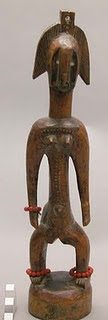The context of my piece provides a great deal of insight into the religion, psychology, and socio-politics of the Bamana. As Kate Ezra said in A Human Ideal in African Art: Bamana Figurative Sculpture:
“More so than masks that tell us about the Bamana world view through the symbolic language of their constituent materials and animal imagery, the figures provide more direct insight into Bamana ideas concerning people and their lives. By portraying men and women with particular features, attributes, and gestures, they illustrate Bamana concepts of beauty and ideals of character and action. Bamana figurative sculptures show people how to look, how to behave towards each other, and what goals to strive for…. The figures are unique in that they do this directly, with tangible, visible forms, and in public contexts that are accessible to all members of the community." (Ezra 1986)
As far as religion goes, it has been posed that my figure could have been used in association with either fertility or the ancestors. Fertility is more likely, as my figure is wooden, and it appears that mostly iron sculptures are used in ancestral rituals. Historian Kjersmeier once postulated that the figure could have been given to young girls to dance with, to ensure that they would be able to bear children upon developing.
But evidence for this is scarce, as the account of the dance “does not correspond to any other accounts of Bamana rituals concerning human fertility, which usually involve women of childbearing ways” (Ezra 1986). Another option for my figure is that it could be a depiction of a deceased family member, particularly a twin. Still, “past generalizations concerning the contexts of Bamana figure sculpture are misleading,” says Ezra. She proposed that my figure could have been mounted on a staff that was used in healing ritual; after the healing, the figure would b broken off the shaft, and young girls would keep it as a toy.
Because my figure is a nyeleni, the most likely option is that my figure could be associated with a Bamana society called the Jo society. This association has strong socio-political significance. Upon initiation, its members would be taken on a certain retreat, and while returning home, the society would use sculpture in dances for the initiate.
Psychologically, this has huge significance, particularly sexually, as Ezra describes:
“That nyeleni figures are identified with sexually appealing unmarried women is evident in the jokes made about the figures. For example, when the initiates arrive in a village in which they are to perform, thet give their statue to the head of the young men there. They tease him, saying that the statue is his girlfriend, and that he can spend the night with her if he gives them money. Later, after… Jo initiation, the statue is referred to as a “widow”. It is stripped of its finery and put away for the next group of initiates seven years later."
Other nyeleni figures, used in Jo initations.
Hence, the religious, psychological, and socio-political implication of my piece are large.
While I am relatively certain that my figure is a nyeleni used in Jo initiation, there are other possibilities, as Ezra says: “Similar forms also characterize Bamana figures used in contexts other than Joe including puppets that are meant to portray seductive female characters.” One example is the following figure:
Alternatively, it could be another type of figure used to initiate Jo women: the sonkalani (for specific initiates called Boso).




No comments:
Post a Comment